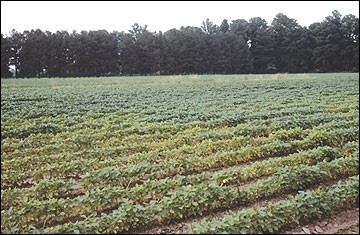Soybean Cyst Nematode

Stunted, yellow soybean plants (foreground) are a sign of infection by soybean cyst nematode.
DR. ANTHONY OHMES
JACKSON, MO.
What is your soybean cyst nematode (SCN) egg population? If you can’t accurately answer this question, you are not alone. One survey indicated that 64 percent of producers have never sampled their fields and 25 percent have not sampled for greater than 5 years. If you fall into one of these categories and are a soybean producer, it may be time to consider a SCN egg count. SCN falls under plant pathology and is ranked number one for disease yield loss in the U.S. SCN is deceiving since it takes very high populations to cause above ground visual symptoms and much lower populations to actually reduce yield 15 percent to 30 percent with little to no visual symptoms.
As with any pest, scouting and monitoring changes over time is critical. A yield monitor is a great tool to identify locations in fields where yield loss cannot be linked to any definite above visual problems such as thin stand, weeds, insects, nutrients, etc. The one exception is a correlation to sudden death (SDS) and SCN, so sampling may be warranted where SDS symptoms were identified. Once those locations are identified, scouting requires soil sampling and submitting a sample to the nematology lab for an egg count. Follow the link to the MU Nematology website for sampling and submitting samples: http://soilplantlab.missouri.edu/nematode/samples.aspx. Egg counts can be taken any time of year, however, the ideal time is fall/winter after harvest.
A number of factors have occurred over the years that could lead to a buildup of these pests in your field. 1) A farm’s soil texture does not have to be beach sand to have a nematode population. Granted, a Sharkey clay would not be conducive to explosive nematode buildup. 2) There is a limited genetic pool of resistance where the dominant trait of most commercial SCN soybean lines is PI88788. Therefore fields of continuous soybean and even fields in rotation could see a specie shift due to selection pressure. 3) The high efficacy of PI88788 has given many a sense of security over the years to where testing has simply been forgotten. 4) There has been other “bigger” problems soybean producers have had on the front burner, namely – PIGWEED.
Management includes: 1) scouting and monitoring changes in egg numbers. Sample thoroughly because results are only as good as the sample taken. For monitoring, mark your sample locations so when you do come back in a few years you are comparing as best you can apples to apples. 2) keeping non-host crops in rotation. Non-host crops include corn, sorghum, winter cereal grains, clover, alfalfa, and forage grasses. 3) grow resistant varieties. If egg counts have increased, an HG test can help direct to what type of resistance may be needed. Unfortunately your resistance options include: PI88788, Peking, and Hartwig. The Hartwig gene is considered complete SCN nematode resistance. 4) nematicide seed treatments are available. There is limited research on these products and if considered, use in conjunction with soybeans containing PI88788 or Peking resistance. ∆
DR. ANTHONY OHMES: Agronomy Specialist, University of Missouri